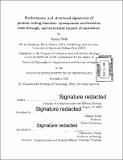Evolutionary and structural signatures of protein-coding function : synonymous acceleration, read-through, and structural impact of mutations
Author(s)
Wolf, Maxim,Ph. D.(Maxim Y.)Massachusetts Institute of Technology.
Download1196090379-MIT.pdf (9.261Mb)
Other Contributors
Massachusetts Institute of Technology. Computational and Systems Biology Program.
Advisor
Manolis Kellis.
Terms of use
Metadata
Show full item recordAbstract
In this thesis I observe evolutionary signatures in coding regions to: (1) understand the sources of highly mutable coding regions in mammals; (2) to elucidate a new candidate function for a stop codon readthrough candidate gene, BRI3BP; and (3) to show how rapid sequence-based structure approximations can help predict the structural impact of amino-acid changes. (1) First, I searched for deviations from the evolutionary signatures of coding regions to recognize synonymous acceleration elements (SAEs) in protein coding genes. I showed that these are driven by an increased mutation rate, which persists in the human lineage, in otherwise evolutionarily-constrained protein-coding regions, providing an important resource to better characterize protein-coding constraint in mammals and within humans. (2) Second, I combined evolutionary signatures at the protein-coding and protein-folding level to characterize the functional implication of stop-codon readthrough in BRI3BP. I showed that this readthrough region has conserved spaced hydrophobic residues that pattern match to the -terminal helix forming a coiled-coil-like domain. This change alters BRI3BP function from pro-growth to pro-apoptotic, similarly to VEGF-A. This suggests that readthrough-triggered apoptosis may represent a general mechanism for limiting growth of cells with aberrant ribosomal termination. (3) Third, I used rapid protein-structure approximation of burial of residues based on protein sequence to predict the structural impact of amino acid alterations. I show that the prediction can be improved over using exclusively the hydrophobicity change of the residue. Overall my work demonstrates how evolutionary and structural signatures can be used to predict highly mutational gene regions, readthrough function and structural impact of mutation.
Description
Thesis: Ph. D., Massachusetts Institute of Technology, Computational and Systems Biology Program, 2019 Cataloged from the PDF of thesis. Includes bibliographical references (pages 87-90).
Date issued
2019Department
Massachusetts Institute of Technology. Computational and Systems Biology ProgramPublisher
Massachusetts Institute of Technology
Keywords
Computational and Systems Biology Program.